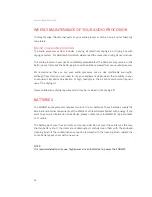
General precautions and warnings
44
The following section applies to the SYNCHRONY ABI auditory brainstem implant only
MRI CAUTION
Evidence has been provided for this implant type to pose no known hazard in specifi ed
MRI environments (without surgical removal of the internal magnet) when adhering to the
conditions and Safety Guidelines listed below. The implant has a specially designed magnet
which allows safe MRI scanning with the magnet in place, and there is no need to remove
the implant magnet regardless of the scanner fi eld strength. The implant magnet can be
surgically removed if needed to avoid imaging artefacts. The physician/MRI operator should
always be informed that a patient is an auditory brainstem implant user and that special
safety guidelines have to be followed.
MRI scanning is possible in consideration of the Safety Guidelines if the following
conditions are fulfi lled:
• MRI scanners with static magnetic fields of 0.2 T, 1.0 T, or 1.5 T only. No other field
strengths are allowed. When using other field strengths, injury to the patient and/or
damage to the implant are possible.
• In case of additional implants, e.g. a hearing implant in the other ear: MRI safety
guidelines for this additional implant need to be met as well.
Safety Guidelines:
• Before patients enter any MRI room all external components of the implant system
(audio processor and accessories) must be removed from the head. For field strengths of
1.0 T and 1.5 T, a supportive head bandage must be placed over the implant. A supportive
head bandage may be an elastic bandage wrapped tightly around the head at least three
times (refer to Fig. A). The bandage shall fit tightly but should not cause pain. Performing
an MRI without head bandage could result in pain in the implant area and in worst case
can lead to migration of the implant and/or dislocation of the implant magnet.
• Head orientation: In case of 1.0 T and 1.5 T MRI systems, straight head orientation is
required. The patient should not incline his/her head to the side; otherwise torque is
exerted onto the implant magnet which could cause pain. In case of 0.2 T scanners, no
specific head orientation is required.
• Sequences in Normal Operating Mode shall be used only.
• During the scan patients might perceive auditory sensations such as clicking or beeping.
Adequate counselling of the patient is advised prior to performing the MRI. The likelihood
and intensity of auditory sensations can be reduced by selecting sequences with lower
specific absorption rate (SAR) and slower gradient slew rates.
• The magnet can be removed to reduce image artefacts. If the magnet is not removed,
image artefacts are to be expected (refer to Fig. B).






























